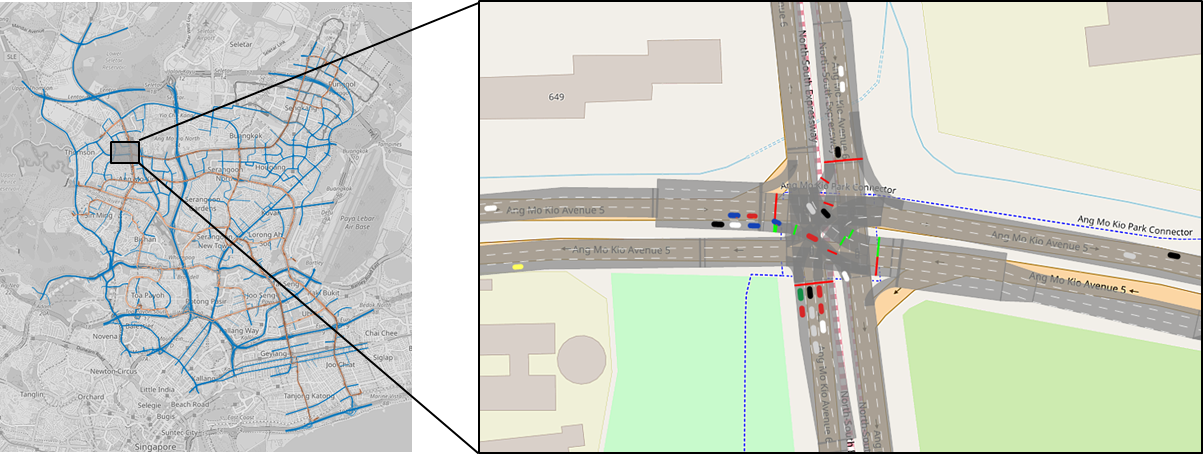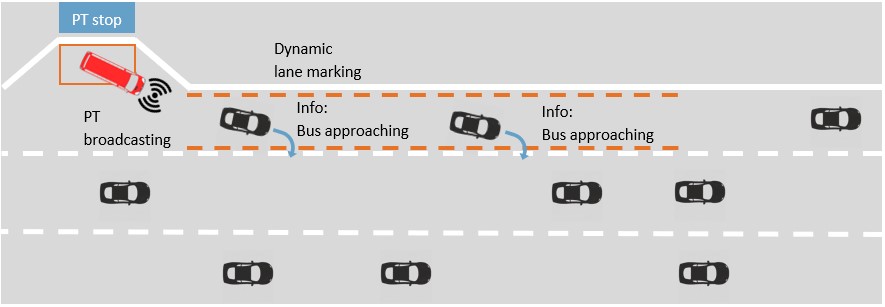- AquaCycle
- Proteins4Singapore
- Singapore's Pathway to Carbon Neutrality
- CellFACE
- LightSPAN
- Computational Modelling Group
- Energy and Power Systems Group
- SITEM - Singapore Integrated Transport and Energy Model
- MoVES (Mobility in Vehicular Environments at Scale) lab
- Projects
RRT-2 — Technologies for Holistic Traffic Management and Control
This research group aims to achieve fast and reliable public transport services in a mixed traffic environment while minimising the impact on overall traffic. With the development of integrated and innovative vehicle and traffic modelling operations and practices, RRT-2 has made significant contributions in terms of the traffic management to support the operation of DART and general public transport (PT) systems. The ongoing research is divided into five main areas:
Development of an Integrated Microscopic Traffic Simulation Model
A comprehensive microscopic simulation model has been developed for simulating the entire DART study area, consisting of real-life road geometry and signal timings, calibrated private traffic demand, DART planning and scheduling, and more. The model has been expanded to include autonomous driving behaviour and will further include vehicle communication systems. This simulation model is used as a testbed throughout the research timeline to enable the analysis and evaluation of the developed methodologies.
Figure 1: The DART study area in microscopic traffic simulation
Contact: Xiaodong LIU
Fleet Operation of the Autonomous Public Transport (PT) Vehicles for the DART System
Another goal is to materialise the proposed coupling mechanism of the DART modules. Under this strategy, DART modules are planned to couple at pre-defined time windows and stops, with an iterative scheduling comprised of departure times and coupling locations. This strategy is extended with a rule-based logic to handle delays as well as to maintain the correct sequence of modules. The coupling methodology strengthens all the below described PT prioritization measures. It lowers the arrival rate and organizes the rather random arrivals of PT vehicles compared to today’s operation. This enables the traffic signal controls at intersections to handle the coupled PT vehicle arrivals and provide green signals to them, mitigate unnecessary delays of PT vehicles at intersection and maintain the quality of service of general traffic. As a result, the travel speed of PT vehicles through the road network will be increased and hence make the PT service punctual and better for passengers.
Figure 2: Illustration of the DART coupling
Contact: Xiaodong LIU
Pro-active Transport Management
This research develops strategic traffic management technologies for the efficient use of road infrastructure by both public and private transport, enabling an accelerated and reliable operation within the network. Pro-active transport management measures such as virtual right-of-way, green light optimized speed advisory or ad-hoc platooning will be defined and developed. These measures not only provide the different prioritisation levels for PT at the times and places where necessary, but also to enable ad-hoc tactical decisions. Additionally, the related operational technologies and planning schemes for accelerating public transport will be introduced and assessed.
Figure 3: Virtual Right-of-Way concept
Contact: Meng XIE
Real-time Urban Traffic Control
A coordinated signal control is being developed to mitigate unnecessary delays of the DART modules and other public transport vehicles at signalised intersections. The methodology incorporates the predicted arrival times and the minimum required crossing times of PT vehicles, in order to provide signal priority to PT vehicles and minimise the impact on private traffic.
Integrated with DART coupling strategy and V-RoW, this algorithm has been examined on a 1.6 km long test network with two signalised intersections and two DART stops (as partially shown in Figure 4) under different traffic and planning scenarios. Simulations show promising results with significant improvements in DART travel speed and reliability while having only a minor impact on private traffic over the test network.
Figure 4: A partial network for the performance test of the Integrated DART traffic operation
Contact: Xiaodong LIU
Passenger-centric Incident Management
Incidents in this context are defined as traffic accidents, road congestion, vehicle breakdown, high public transport (PuT) demand during peak hours or any similar event. In other words, anything that can cause a deviation from the scheduled PuT service. These deviations lead to increased travel times for passenger as well as operating costs. In order to mitigate these negative impacts and to improve the reliability of the PuT system, a real-time passenger redirecting system that suggests alternative paths with underutilised capacities is being developed. This new passenger-centric approach is under investigation at RRT to complement the conventional vehicle- and operator-centric incident management to react to incidents, such as holding and bus rerouting. In the picture below, one can see an example of the altered path of passengers due to an incident on their original path. Depending on, how close the passengers are to the incident they get can be redirected or not.
Figure 5: Illustration of an alterered passengers' path during an incident.png)
Contact: Frederik BACHMANN

